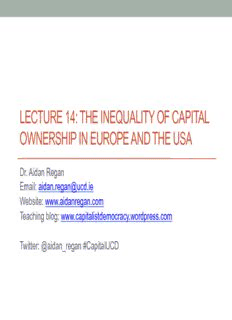Table Of ContentLECTURE 14: THE INEQUALITY OF CAPITAL
OWNERSHIP IN EUROPE AND THE USA
Dr. Aidan Regan
Email: [email protected]
Website: www.aidanregan.com
Teaching blog: www.capitalistdemocracy.wordpress.com
Twitter: @aidan_regan #CapitalUCD
Introduction
• In this lecture we are returning to the question of wealth
inequality (i.e. inequalities arising from capital ownership).
• Global wealth today is estimated at approximately $262
trillion. 44% of this is estimated to be owned by 0.7% of
the world's population.
• Last week we concluded that the only reason why income
inequality declined in the 20th century was because the
income arising from capital ownership declined.
• It is therefore essential that we understand how this
compression in the inequality of wealth came about.
Reminder
Table 7.2. Inequality of capital ownership across time and space
Low Medium Medium-
High Very high
inequality inequality high
inequality inequality
Share of different groups (never observed; (≈ Scandinavia, inequality
(≈ U.S. 2010) (≈ Europe 1910)
in total capital ideal society?) 1970s-1980s) (≈ Europe 2010)
The top 10%
30% 50% 60% 70% 90%
"Upper class"
including: the top 1%
10% 20% 25% 35% 50%
("dominant class")
including: the next 9% ("well-
20% 30% 35% 35% 40%
to-do class")
The middle 40%
45% 40% 35% 25% 5%
"Middle class"
The bottom 50%
25% 10% 5% 5% 5%
"Lower class"
Corresponding Gini coefficient
0.33 0.58 0.67 0.73 0.85
(synthetic inequality index)
Insocietieswith"medium"inequalityofcapitalownership(suchasScandinaviancountriesinthe1970s-1980s),thetop10%richestinwealthownabout50%
ofaggregatewealth,thebottom50%poorestabout10%,andthemiddle40%about40%.ThecorrespondingGinicoefficientisequalto0.58.Seetechnical
appendix.
Capital ownership
• Table 7.2 shows that in all known societies the poorest half of
the population own virtually nothing (generally 5% of wealth).
• The world of the 21st century is no different to the world of the 19th
century in this sense.
• The top decile have generally owned between 60-90% of
wealth. The middle classes have generally owned between
5-35%. This emergence of a property owning middle class
transformed wealth distribution in the 20th century.
• Let's take a look at these empirical trends in Europe and the
USA overtime.
France
Figure 10.1. Wealth inequality in France, 1810-2010
100%
90%
80%
h
alt
e
w 70%
al
ot
e in t 60%
ntil
e
erc 50%
p
or
e 40%
cil
e
d
op 30% Top 10% wealth share
of t
e
ar 20%
h Top 1% wealth share
S
10%
0%
1810 1830 1850 1870 1890 1910 1930 1950 1970 1990 2010
The top decile (the top 10% highest wealth holders) owns 80-90% of total wealth in 1810-1910, and 60-65% today.
Sources and series: see piketty.pse.ens.fr/capital21c.
France
• What we observe in France is that the top decile owned between 80-90% of
wealth from 1810-1910 and 60-65% today.
• This longitudinal data is available because of the introduction of an estate tax
in 1791 on all forms of wealth; property, assets, bonds, land.
• Looking at these trends in capital ownership it is interesting to ask what would
have happened had there been no war?
• France was a patrimonial society characterized by a hyper-concentration of
wealth. The decline in the upper decile share of wealth in the 20th century
went exclusively to the middle 40 percent of the population.
• The poorest 60 percent owned nothing in the 19th and the 21st century. Much
like the structure of wage inequality - this has not changed.
Britain
Figure 10.3. Wealth inequality in Britain, 1810-2010
100%
90%
h
alt 80%
e
w
otal 70%
n t
e i
ntil 60%
e
c
er
p 50%
p
o
or t
e 40%
ci Top 10% wealth share
e
d
p 30%
o
of t Top 1% wealth share
e
ar 20%
h
S
10%
0%
1810 1830 1850 1870 1890 1910 1930 1950 1970 1990 2010
The top decile owns 80-90% of total wealth in 1810-1910, and 70% today.
Sources(and(series:(see(pike0y.pse.ens.fr/capital21c.((
Sweden
Figure 10.4. Wealth inequality in Sweden, 1810-2010
100%
90%
h 80%
alt
e
w
al 70%
ot
n t
e i 60%
ntil
e
c
er 50%
p
or
e
ci 40%
de Top 10% wealth share
p
o
of t 30%
e Top 1% wealth share
ar
h 20%
S
10%
0%
1810 1830 1850 1870 1890 1910 1930 1950 1970 1990 2010
The top 10% holds 80-90% of total wealth in 1810-1910, and 55-60% today.
Sources and series: see piketty.pse.ens.fr/capital21c.
Britain and Sweden
• Figure 10.3 and figure 10.4 show that the same extreme
concentration of capital ownership and wealth existed in Britain and
Sweden. It was a European wide phenomenon.
• In Britain, the top decile owned 80-90 percent of total wealth in 1910
and 70 percent today.
• In 1910, Sweden was just as unequal. It was nothing like the
egalitarian country it became during the 1970's.
• The essential difference today is that there is a property owning
middle class - who own about one third of national wealth. The
wealthiest 10 percent lost to the middle 40 percent during the period
of strong growth in the 20th century.
• Nothing went to the poorest half of the population.
USA
Figure 10.5. Wealth inequality in the U.S., 1810-2010
100%
h 90%
alt
e
w
al 80%
ot
n t
e i 70%
ntil
e
c
er 60%
p
or
e
cil 50%
e
d
p
of to 40%
e
ar
h 30%
S
Top 10% wealth chare
20%
10% Top 1% wealth share
0%
1810 1830 1850 1870 1890 1910 1930 1950 1970 1990 2010
The top 10% wealth holders own about 80% of total wealth in 1910, and 75% today.
Sources and series: see piketty.pse.ens.fr/capital21c.
Description:Dr. Aidan Regan. Email:
[email protected]. Website: www.aidanregan.com. Teaching blog: www.capitalistdemocracy.wordpress.com.

